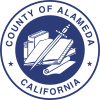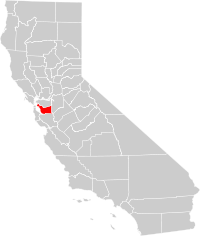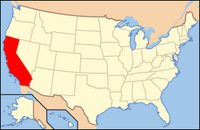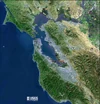| ||||||||||||||
| County of Alameda | |||
|---|---|---|---|
| — County — | |||
| Alameda County Court House in Oakland | |||
|
|||
| Location in the state of California | |||
| California's location in the United States | |||
| Country | |||
| State | |||
| Region/Metro area | San Francisco Bay Area | ||
| Incorporated | March 25, 1853 | ||
| County seat | Oakland | ||
| Largest city | Oakland | ||
| Area | |||
| • Total | 821.15 sq mi (2,126.8 km2) | ||
| • Land | 737.57 sq mi (1,910.3 km2) | ||
| • Water | 83.57 sq mi (216.4 km2) | ||
| Population (2010) | |||
| • Total | 1,510,271 | ||
| • Density | 2,047.6/sq mi (790.6/km2) | ||
| Time zone | Pacific Standard Time (UTC-8) | ||
| • Summer (DST) | Pacific Daylight Time (UTC-7) | ||
| Area code(s) | 510, 925 | ||
| Website | www.acgov.org | ||
Alameda County is a county in the U.S. state of California.[1] It occupies most of the East Bay region of the San Francisco Bay Area.[1] As of the 2010 census it had a population of 1,510,271,[2] making it the 7th largest county in the state.[3] The county includes the cities of Oakland and Berkeley, and Oakland is its seat.
History
The county was formed on March 25, 1853 from a large portion of Contra Costa County and a smaller portion of Santa Clara County.
The Spanish word alameda means "a place where poplar trees grow", a name which originally was given to the Arroyo de la Alameda (Poplar Grove Creek). The willow and sycamore trees along the banks of the river reminded the early explorers of a road lined with trees, also known as an alameda.
The county seat at the time it was formed was located at Alvarado; it was moved to San Leandro in 1856 where the county courthouse was destroyed by the devastating 1868 quake on the Hayward Fault. The county seat was then re-established in the town of Brooklyn from 1872-1875. Brooklyn is now part of Oakland, which has been the county seat since 1873.
Much of what is now considered an intensively urban region, with major cities, was developed as a trolley car suburb of San Francisco in the late 19th and early 20th centuries. The historical progression from native American tribal lands to Spanish, then Mexican ranches, then to farms, ranches, and orchards, then multiple city centers and suburbs, is shared with the adjacent and closely associated Contra Costa County.
Government
The county is divided into five districts. A County Supervisor is elected in each district, with an election held every four years. This elected group is known as the Board of Supervisors. Currently, District 1 is represented by Supervisor Scott Haggerty; District 2, Supervisor Nadia Lockyer; District 3, Supervisor Wilma Chan; District 4, Supervisor Nate Miley; District 5, Supervisor Keith Carson. The Board elects a president who presides at all meetings of the Board and appoints committees to handle work involving the major programs of the county. If the president is absent for a meeting, the vice president shall be responsible. A Board election occurs every two years for these positions. Supervisor Miley is serving currently as president; Supervisor Carson is vice president.
Board meetings are open to the public, and occur every Tuesday (with the exception of holidays and board retreats) at 9:00 am in the County Administration Building in Oakland. Day-to-day administrative operations are handled by the County Administrator. This position is appointed by the Board of Supervisors, currently held by Susan Muranishi.
The county's law enforcement is overseen by an elected Sheriff/Coroner and an elected District Attorney. The Sheriff supervises the deputies of the Alameda County Sheriff's Office, whose primary responsibilities include policing unincorporated areas of the county and cities within the county which contract with the Sheriff's Office for police services; providing security and law enforcement for county buildings including courthouses, the county jail and other county properties; providing support resources, such as a forensics laboratory and search and rescue capabilities, to other law enforcement agencies throughout the county; and serving the process of the county's Superior Court system. The District Attorney's office is responsible for prosecuting all criminal violations of the laws of the state of California, the county, or its constituent municipalities, in the Alameda County Superior Court. As of late 2009, the Sheriff is Gregory J. Ahern, who was elected in 2006 to replace Charles C. Plummer, who had served in the post for 20 years. The Interim District Attorney is Nancy E. O'Malley, who was appointed to fill the position of retiring District Attorney Tom Orloff in September 2009. The Sheriff's Office operates two jails, one being Santa Rita Jail located in Dublin.
The Alameda County Fire Department (ACFD)[4] was formed on July 1, 1993 as a dependent district, with the Board of Supervisors as its governing body. Municipal and specialized fire departments have been consolidated into the ACFD over the years. 1993 brought in the Castro Valley and Eden Consolidated FD, and the County Fire Patrol. San Leandro joined in 1995, Dublin in 1997, Lawrence Berkeley National Laboratory in 2002, Lawrence Livermore National Laboratory in 2007, The Alameda County Regional Emergency Communications Center in 2008, and Newark and Union City in 2010.
The Alameda County Water District is operated by the county.
The county's Superior Court operates in twelve separate locations throughout the county, with its central Rene C. Davidson Courthouse located in Oakland near Lake Merritt. Most major criminal trials and complex civil cases are heard at this location or in courtrooms within the County Administration Building across the street.
Events
The annual county fair is held at the Alameda County Fairgrounds in Pleasanton. The fair runs for 3 weekends from June to July. Attractions include horse racing, carnival rides, 4-H exhibits, and live bands.
Geography
According to the 2000 census, the county has a total area of 821.15 square miles (2,126.8 km2), of which 737.57 square miles (1,910.3 km2) (or 89.82%) is land and 83.57 square miles (216.4 km2) (or 10.18%) is water.[5]
The San Francisco Bay borders the county on the west, and the City and County of San Francisco, California has a small land border with the city of Alameda due to land filling [4]. The crest of the Berkeley Hills form part of the northeastern boundary, and reach into the center of the county. A coastal plain several miles wide lines the bay; it is home to Oakland and the most populous regions. Livermore Valley lies in the eastern part of the county.
The Hayward Fault, a major branch of the San Andreas Fault to the west, runs through the most populated parts of Alameda County, while the Calaveras Fault runs through the southeastern part of the county.
Incorporated cities

View of downtown Oakland looking west across Lake Merritt.

View of Berkeley and the San Francisco Bay at nightfall.

The reconstructed mission at Mission San José (located in Fremont).
- Alameda, a charter city formed in 1916
- Albany, incorporated as the City of Ocean View in 1908, renamed Albany in 1909
- Berkeley, incorporated 1878
- Dublin, initially the Murray Township (1868), incorporated as Dublin in 1982
- Emeryville, incorporated 1896
- Fremont, incorporated 1956, combining the former communities of Centerville, Niles, Irvington, Mission San Jose, and Warm Springs
- Hayward, named as early as 1852, chartered as Haywards in 1876, incorporated as Hayward in 1928
- Livermore, incorporated 1876
- Newark, incorporated 1955
- Oakland, incorporated 1852
- Piedmont, incorporated 1907
- Pleasanton, incorporated 1894
- San Leandro, incorporated 1872
- Union City, incorporated 1959
Unincorporated communities
The unincorporated communities in Alameda County are governed directly by the county. Alameda County has 6 major unincorporated communities that qualify as census designated places (CDP):
- Ashland, east of San Leandro
- Castro Valley, north of Hayward, east of San Leandro
- Cherryland, north of Hayward
- Fairview, north of Hayward
- Sunol, east of Fremont
- San Lorenzo, south of San Leandro, north of Hayward
The county has a number of smaller named neighborhoods, not governed by cities.
|
|
|
Former townships
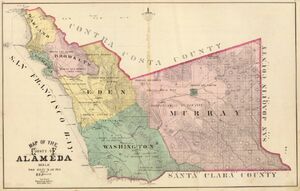
Map of Alameda County, 1878 (Six Townships)
- Oakland Township - the northern portion subsequently became the cities of Berkeley and Albany
- Alameda Township - Now essentially coterminus with the City of Alameda
- Brooklyn Township - Mostly contained within Oakland and Piedmont
- Eden Township - parts have been incorporated into San Leandro and Hayward, the rest contains the communities of Castro Valley, San Lorenzo, and other unincorporated areas.
- Washington Township - contains Union City, Newark, Fremont, and small unincorporated areas nearby.
- Murray Township - Contains cities of Dublin, Pleasanton, and Livermore, and substantial unincorporated areas including Sunol.
Adjacent counties
- Santa Clara County, California - south
- San Mateo County, California - west
- San Francisco County, California - west
- Contra Costa County, California - north
- San Joaquin County, California - east
- Stanislaus County, California - southeast by a corner
National protected area
- Don Edwards San Francisco Bay National Wildlife Refuge (part)
Transportation infrastructure
Major highways
|
Mass transit
- ACE train - commuter rail using existing railroad tracks; primarily brings commuters from San Joaquin County to Santa Clara County
- AC Transit - local bus system in western Alameda County and west Contra Costa County, with additional service across the three bridges from Alameda County to downtown San Francisco, San Mateo, and Palo Alto
- BART - commuter rail centered on northwest Oakland, primarily serving commuters to downtown San Francisco and downtown Oakland
- Capitol Corridor - commuter rail using existing railroad tracks, extending from San Jose to Sacramento, running through western Alameda County
- WHEELS - bus system in the cities of southeastern Alameda County
- Union City Transit - local city bus service within Union City in addition to AC Transit
- Emery-Go-Round - free bus service in Emeryville.
- Alameda / Oakland Ferry and Harbor Bay Ferry - connect Oakland, Alameda, and Bay Farm Island with downtown San Francisco
- San Joaquins - Amtrak route between Oakland and Bakersfield through Fresno and the Central Valley
- VTA - commuter service between southern Alameda county and job centers in the Silicon Valley
- Dumbarton Express - additional service across the Dumbarton Bridge between Fremont and Palo Alto
Demographics
| Census | Pop. | %± | |
|---|---|---|---|
| 1860 | 8,927 | ||
| 1870 | 24,237 | 171.5% | |
| 1880 | 62,976 | 159.8% | |
| 1890 | 93,864 | 49.0% | |
| 1900 | 130,197 | 38.7% | |
| 1910 | 246,131 | 89.0% | |
| 1920 | 344,177 | 39.8% | |
| 1930 | 474,883 | 38.0% | |
| 1940 | 513,011 | 8.0% | |
| 1950 | 740,315 | 44.3% | |
| 1960 | 908,209 | 22.7% | |
| 1970 | 1,073,184 | 18.2% | |
| 1980 | 1,105,379 | 3.0% | |
| 1990 | 1,279,182 | 15.7% | |
| 2000 | 1,443,741 | 12.9% | |
| 2010 | 1,510,271 | 4.6% | |
|
2010
The 2010 United States Census reported that Alameda County had a population of 1,510,271. The population density was 2,047.6 people per square mile (790.6/km²). The racial makeup of Alameda County was 649,122 (43.0%) White, 190,451 (12.6%) African American, 9,799 (0.6%) Native American, 394,560 (26.1%) Asian, 12,802 (0.8%) Pacific Islander, 162,540 (10.8%) from other races, and 90,997 (6.0%) from two or more races. Hispanic or Latino of any race were 339,889 persons (22.5%).[7]
| Population reported at 2010 United States Census | |||||||||
|---|---|---|---|---|---|---|---|---|---|
Population |
American |
American |
Islander |
races |
more races |
or Latino (of any race) | |||
| Alameda County | 1,510,271 | 649,122 | 190,451 | 9,799 | 394,560 | 12,802 | 162,540 | 90,997 | 339,889 |
cities |
Population |
American |
American |
Islander |
races |
more races |
or Latino (of any race) | ||
| Alameda | 73,812 | 37,460 | 4,759 | 426 | 23,058 | 381 | 2,463 | 5,265 | 8,092 |
| Albany | 18,539 | 10,128 | 645 | 88 | 5,790 | 37 | 607 | 1,244 | 1,891 |
| Berkeley | 112,580 | 66,996 | 11,241 | 479 | 21,690 | 186 | 4,994 | 6,994 | 12,209 |
| Dublin | 46,036 | 23,634 | 4,347 | 246 | 12,321 | 287 | 2,458 | 2,743 | 6,663 |
| Emeryville | 10,080 | 4,490 | 1,764 | 44 | 2,775 | 16 | 348 | 643 | 927 |
| Fremont | 214,089 | 70,320 | 7,103 | 976 | 108,332 | 1,169 | 13,605 | 12,584 | 31,698 |
| Hayward | 144,186 | 49,309 | 17,099 | 1,396 | 31,666 | 4,535 | 30,004 | 10,177 | 58,730 |
| Livermore | 80,968 | 60,418 | 1,702 | 476 | 6,802 | 277 | 6,960 | 4,333 | 16,920 |
| Newark | 42,573 | 17,566 | 2,002 | 279 | 11,571 | 621 | 7,735 | 2,799 | 14,994 |
| Oakland | 390,724 | 134,925 | 109,471 | 3,040 | 65,811 | 2,222 | 53,378 | 21,877 | 99,068 |
| Piedmont | 10,667 | 7,917 | 144 | 6 | 1,939 | 13 | 94 | 554 | 421 |
| Pleasanton | 70,285 | 47,058 | 1,190 | 226 | 16,322 | 134 | 2,002 | 3,353 | 7,264 |
| San Leandro | 84,950 | 31,946 | 10,437 | 669 | 25,206 | 642 | 11,295 | 4,755 | 23,237 |
| Union City | 69,516 | 16,640 | 4,402 | 329 | 35,363 | 892 | 7,253 | 4,637 | 15,895 |
places |
Population |
American |
American |
Islander |
races |
more races |
or Latino (of any race) | ||
| Ashland | 21,925 | 6,705 | 4,269 | 232 | 4,031 | 260 | 5,124 | 1,304 | 9,394 |
| Castro Valley | 61,388 | 35,602 | 4,260 | 329 | 13,140 | 417 | 3,757 | 3,883 | 10,689 |
| Cherryland | 14,728 | 6,035 | 1,698 | 200 | 1,404 | 310 | 4,016 | 1,065 | 7,955 |
| Fairview | 10,003 | 4,499 | 2,105 | 76 | 1,525 | 129 | 913 | 756 | 2,171 |
| San Lorenzo | 23,452 | 11,115 | 1,136 | 228 | 5,054 | 182 | 4,207 | 1,530 | 8,843 |
| Sunol | 913 | 780 | 1 | 6 | 48 | 7 | 19 | 52 | 91 |
communities |
Population |
American |
American |
Islander |
races |
more races |
or Latino (of any race) | ||
| All others not CDPs (combined) | 8,857 | 5,579 | 676 | 48 | 712 | 85 | 1,308 | 449 | 2,737 |
2000
As of the census[8] of 2000, there were 1,443,741 people, 523,366 households, out of which 32.60% had children under the age of 18 living within them, 47.00% married couples living together, 13.00% had a female householder with no husband present, and 35.20% were non-families. 26.00% of all households were made up of individuals and 7.30% had someone living alone who was 65 years of age or older. The average household size was 2.71 and the average family size was 3.31.
In the county, the population was spread out with 24.60% under the age of 18, 9.60% from 18 to 24, 33.90% from 25 to 44, 21.70% from 45 to 64, and 10.20% who were 65 years of age or older. The median age was 34 years. For every 100 females there were 96.60 males. For every 100 females age 18 and over, there were 94.00 males.
The median income for a household in the county was $55,946, and the median income for a family was $65,857 (these figures had risen to $66,430 and $81,341 respectively as of a 2007 estimate[9]). Males had a median income of $47,425 versus $36,921 for females. The per capita income for the county was $26,680. About 7.70% of families and 11.00% of the population were below the poverty line, including 13.50% of those under age 18 and 8.10% of those age 65 or over.
Politics
Alameda County is a stronghold of the Democratic Party. It has not voted for a Republican presidential candidate since 1956, when Dwight Eisenhower carried the county. Historically, the county was Republican until the 1958 defeat of William F. Knowland. Even when Ronald Reagan won the national popular vote by an 18.3% margin in 1984, Walter Mondale won Alameda County by a slightly larger margin. In 2004 it voted for John Kerry by a margin of over 50%. Every city and town voted Democratic.[10] In the House of Representatives, all of the 9th district, parts of the 10th and 11th districts, and most of the 13th district are in the county. All four districts are held by Democrats: Barbara Lee, John Garamendi, Jerry McNerney, and Pete Stark, respectively.
In the State Assembly, parts of the 14th and 15th districts, all of the 16th and 18th districts, and most of the 20th district are in the county. All of its five legislators are Democrats: Nancy Skinner of the 14th district, Sandré Swanson of the 16th district, Mary Hayashi of the 18th district, and Bob Wieckowski of the 20th district, and Joan Buchanan of the 15th district. In the State Senate, most of the 9th and 10th districts are in the county and are both represented by Democrats: Loni Hancock and Ellen Corbett, respectively.
According to the California Secretary of State, there are 709,414 registered voters in Alameda County. 401,847 (56.6%) are registered Democrats, 116,864 (16.5%) are registered Republicans, 33,689 (4.8%) are registered to minor political parties, and 157,014 (22.1%) declined to answer. This means Democrats have a 40.1% registration advantage over Republicans. Every city, town, and unincorporated area in Alameda County has more registered Democrats than Republicans.
| Year | GOP | DEM | Others |
|---|---|---|---|
| 2008 | 19.3% 119,554 | 78.9% 489,106 | 1.8% 11,724 |
| 2004 | 23.3% 130,911 | 75.2% 422,585 | 1.5% 8,594 |
| 2000 | 24.1% 119,279 | 69.4% 342,889 | 6.5% 32,168 |
| 1996 | 23.1% 106,581 | 65.8% 303,903 | 11.2% 51,560 |
| 1992 | 20.6% 109,292 | 63.0% 334,224 | 16.3% 86,629 |
| 1988 | 34.0% 162,815 | 64.8% 310,283 | 1.2% 5,899 |
| 1984 | 40.0% 192,408 | 58.7% 282,041 | 1.3% 6,425 |
| 1980 | 38.0% 158,531 | 48.3% 201,720 | 13.7% 57,366 |
| 1976 | 38.1% 155,280 | 57.9% 235,988 | 4.0% 16,413 |
| 1972 | 42.8% 201,862 | 55.0% 259,254 | 2.1% 10,079 |
| 1968 | 37.6% 153,285 | 53.9% 219,545 | 8.5% 34,519 |
| 1964 | 33.5% 142,998 | 66.4% 283,833 | 0.1% 509 |
| 1960 | 45.6% 183,354 | 54.0% 217,172 | 0.4% 1,474 |
| 1956 | 52.4% 192,911 | 47.3% 174,033 | 0.3% 1,187 |
| 1952 | 52.7% 201,976 | 46.5% 178,239 | 0.8% 3,079 |
| 1948 | 46.6% 150,588 | 47.8% 154,549 | 5.6% 18,194 |
| 1944 | 41.8% 122,982 | 57.7% 169,631 | 0.5% 1,374 |
| 1940 | 43.6% 116,961 | 55.2% 148,224 | 1.2% 3,311 |
| 1936 | 35.1% 82,352 | 63.6% 149,323 | 1.3% 3,011 |
| 1932 | 43.7% 89,303 | 52.0% 106,388 | 4.3% 8,761 |
| 1928 | 65.4% 118,539 | 33.6% 60,875 | 1.0% 1,780 |
| 1924 | 61.5% 81,454 | 6.1% 8,020 | 32.5% 43,016 |
| 1920 | 69.1% 73,177 | 20.3% 21,468 | 10.6% 11,244 |
On Nov. 4, 2008 Alameda County voted 62.0 % against Proposition 8, which won statewide, and which amended the California Constitution to ban same-sex marriages. The county garnered the sixth highest "no" vote, by percentage, of all California counties, and the was the second largest county, by total voter turnout, to vote against it.[11]
Arts
The Alameda County Arts Commission, a division of the county administration, under the California Arts Council, was created in 1965. Its fifteen appointed members act in an advisory capacity to the board of supervisors, in promoting the arts. The Oakland Museum of California has a substantial collection of California art works and historical artifacts.
Education
The Alameda County Office of Education oversees seventeen K-12 school districts and one K-8 district in Alameda County. In all, there are approximately 10,000 teachers serving 225,000 students. The ACOE also services three community college districts with a total enrollment of approximately 55,000 students.
The Alameda County Library operates libraries in the cities of Albany, Dublin, Fremont, Newark and Union City and the unincorporated communities of Castro Valley and San Lorenzo. The cities of Alameda, Berkeley, Hayward, Livermore, Oakland and Pleasanton have their own library systems.
Colleges and Universities
Alameda County is home to the University of California, Berkeley, one of the campuses of the University of California system, and one of the largest and most prestigious research universities in the world.
Other colleges and universities located within Alameda county include:
- Berkeley City College
- California State University, East Bay, one of the campuses of the California State University system
- Chabot College, a two year community college, part of the Chabot-Las Positas Community College District
- College of Alameda, a two year community college, part of the Peralta Community College District of northern Alameda County
- Ex'pression College for Digital Arts
- Holy Names University
- Laney College, a two year community college, part of the Peralta Community College system
- Las Positas College
- Merritt College, a two year community college, part of the Peralta Community College system
- Mills College, a private 4 year women's college and coeducational graduate school
- Ohlone College, part of the Ohlone Community College District
- Samuel Merritt University
- University of California, Berkeley, part of the University of California system
School Districts (K-12)
- Alameda Unified School District
- Albany Unified School District
- Berkeley Unified School District
- Castro Valley Unified School District
- Dublin Unified School District
- Emery Unified School District
- Fremont Unified School District
- Hayward Unified School District
- Livermore Valley Joint Unified School District
- Lammersville Joint Unified School District
- New Haven Unified School District
- Newark Unified School District
- Oakland Unified School District
- Piedmont Unified School District
- Pleasanton Unified School District
- San Leandro Unified School District
- San Lorenzo Unified School District
- Sunol Glen Unified School District
Sports
The following sports teams play in Alameda County.
| Club | Sport | Founded | League | Venue |
|---|---|---|---|---|
| California Golden Bears | NCAA | 1868 | NCAA: Pac-10 | California Memorial Stadium (Football), Haas Pavilion (Basketball), Evans Diamond (Baseball) |
| Oakland Athletics | Baseball | 1901 (in Oakland since 1968) | Major League Baseball: American League | Oakland-Alameda County Coliseum |
| Oakland Raiders | American Football | 1960 (in Los Angeles from 1982–1994) | National Football League: American Conference. AFC West | Oakland-Alameda County Coliseum |
| Golden State Warriors | Basketball | 1946 (In Oakland since 1971) | National Basketball Association: Western Conference. | Oracle Arena |
Parks and recreation
There are more than 350 parks located within the county.[12] The East Bay Regional Park District operates within Alameda and neighboring Contra Costa County, with numerous parks within the county, including, Tilden Regional Park, Redwood Regional Park, and Anthony Chabot Regional Park. Eastshore State Park is located partially along the bay shore of northern Alameda County. The San Francisco Bay Trail, a project of the Association of Bay Area Governments, will run along the bay shore of the county.[13]
Services
The county operates hospitals and primary care clinics, through the Alameda County Medical Center.
Landmarks
Alameda County has eight National Historic Landmarks.
See also
- USS Alameda County (LST-32) the only US Naval vessel named after the county
- National Register of Historic Places listings in Alameda County, California
- Solar power in Alameda County
- List of California public officials charged with crimes, Alameda County
External links
- Alameda County's Official Web Site
- [5] map of Alameda County with supervisorial district boundaries
- Alameda County Fairgrounds - Annual county fair June to July
- A short film about Alameda County from 1958
- Short radio episode Baseball from "Lil' Yokohama," by Oakland writer Toshio Mori, 1941. California Legacy Project.
- Alameda County Fire Department
- Alameda County Fire Department Training Division
- Hiking trails in Alameda County, at the Berkeley Wiki website
References
- ^ a b http://www.counties.org/default.asp?id=6
- ^ http://quickfacts.census.gov/qfd/states/06/06001.html
- ^ http://www.alameda.courts.ca.gov/pages.aspx/about-alameda-county
- ^ Alameda County Fire Department
- ^ "Census 2000 U.S. Gazetteer Files: Counties". United States Census. http://www.census.gov/tiger/tms/gazetteer/county2k.txt. Retrieved 2011-02-13.
- ^ http://www.bayareacensus.ca.gov "Demographic Profile Bay Area Census". http://www.census.gov http://www.bayareacensus.ca.gov.
- ^ "2010 Census P.L. 94-171 Summary File Data". United States Census Bureau. http://www2.census.gov/census_2010/01-Redistricting_File--PL_94-171/California/.
- ^ "American FactFinder". United States Census Bureau. http://factfinder.census.gov. Retrieved 2008-01-31.
- ^ Alameda County, California - Fact Sheet - American FactFinder
- ^ pres_general_ssov_for_all.xls
- ^ [1]
- ^ [2]
- ^ [3]

|
Contra Costa County | 
| ||
| San Francisco County and San Mateo County | San Joaquin County | |||
 Alameda County, California | ||||
| Santa Clara County | Stanislaus County |
| ||||||||||||||||||||
| |||||||||||||||||||||||||
| |||||||||||||||||||||||
| This page uses content from the English language Wikipedia. The original content was at Alameda County, California. The list of authors can be seen in the page history. As with this Familypedia wiki, the content of Wikipedia is available under the Creative Commons License. |

